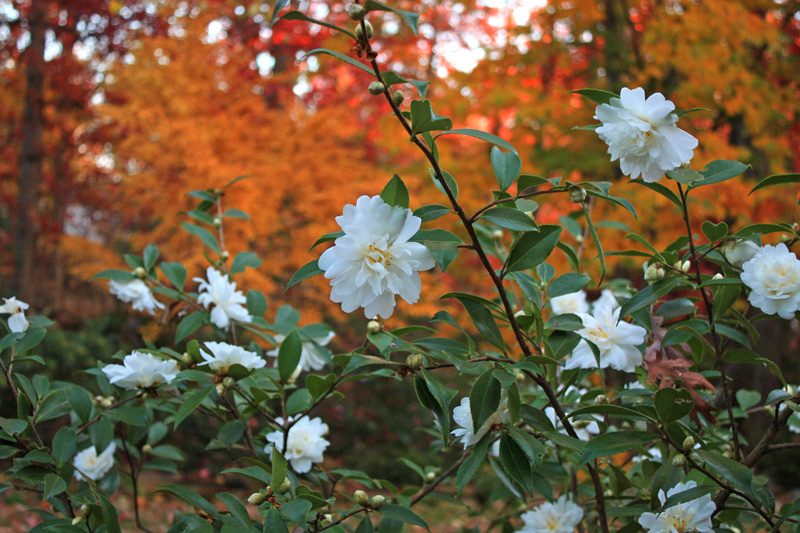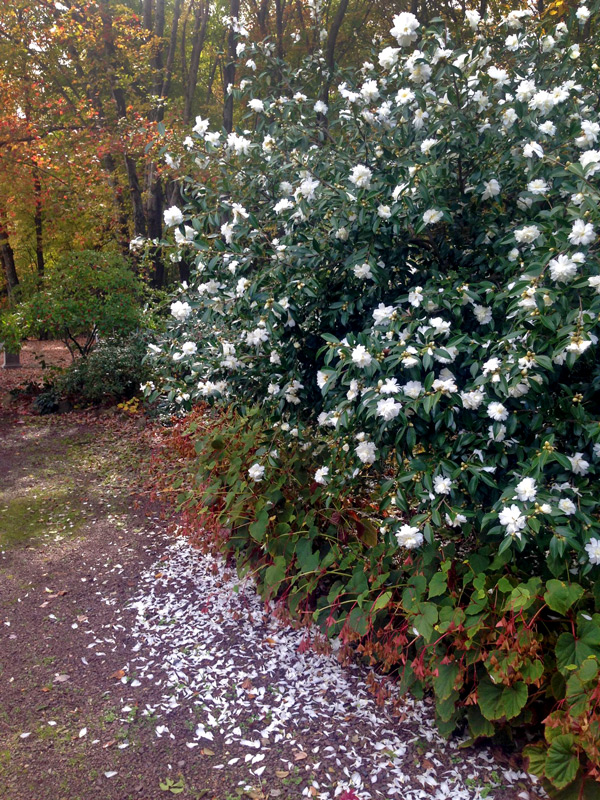Keep the Flowers Coming with Camellias
Gardeners focus their efforts on spring, summer and fall, tending to overlook the potential for beauty in a winter garden. Most people imagine winter as a season of dormancy for many of their plants. However, we can incorporate many plants into our garden which provide gorgeous texture and color in the form of berries, bark or even blooms to accent the wintry landscape. Red twig dogwood, winterberry holly, nandina, helleborus, edgeworthia, and leucothoe are just a few examples. My personal favorite winter blooming plant is the camellia. With flowers in shades of white, pink and red highlighted against lustrous evergreen leaves, camellias make wonderful specimen plants. They are also beautiful when paired with other shrubs, such as deciduous Japanese maple, for contrasting colors in fall and winter landscapes. As a bonus, camellias flowers make the perfect addition to a garden-fresh winter bouquet.
The two most popular types of camellias are:
- Camellia japonica,which blooms in the winter and spring.
- Camellia sasanqua, which blooms in the fall and winter.
Each of these bloom in waves, a process referred to as “buds-in-waiting”. As one flower fades, another bud will open to replace it. This is one of my favorite qualities of the camellia since it extends the bloom season over a longer period of time. As the first wave of flowers fade on the fall and winter blooming Camellia sasanqua, flower petals drift to the ground and cover the area surrounding the plant, creating a stunningly beautiful, snow-like effect.In our area, Camellia sasanqua typically begins blooming early to mid-October and will continue flowering until cold weather sets in, usually in December. Camellia japonica will begin blooming in February and continue until April, depending on the weather.
Camellia Fall and Winter Care
Fertilization
Camellias thrive in moist, well-drained soil and prefer to be sheltered from drying wind and hot mid-day sun. Too much sun and wind will accelerate drying and can cause leaf burn. Lucky for us, camellias prefer our natural acidic soils in the Northern Virginia area. If you have established camellias in your yard, we recommend feeding them with an acidic fertilizer such as Holly-tone now, and then once again in the spring. If you are planting a new camellia this fall, we recommend fertilizing with our Merrifield Starter Plant Food.
Pruning
Like many blooming shrubs and trees, camellias benefit from a light trimming once they are done blooming. Prune your sasanqua camellias at the very beginning of spring before they set their flower buds, and your japonica camellias later in the spring after they complete their bloom.
Winter Care
The cold winters in our area can be hard on newly planted camellias. You can help them along by insulating the plant with leaves during the winter by following these steps:
- After Thanksgiving, drive three to four stakes into the ground around the plant at a distance of about one foot from the center. You want to make sure you have about one to two feet of stake above the ground.
- Wrap burlap or chicken wire around all of the stakes to create a container to keep the leaves from escaping.
- Fill the space you created with the fallen leaves. My favorite leaves to use are those from oak trees as they will curl and crinkle when they dry. Since the leaves don’t lay flat, they will create air pockets that further help with insulation and keeping the ground around it from freezing.
- Top off your oak leaves with a layer of maple leaves. Maple leaves dry flat and will create a seal on top of the insulating oak leaves.
- If the temperature is above 45 degrees, you can also spray your camellias with Wilt Pruf to seal the moisture into the leaves and prevent water from evaporating.



